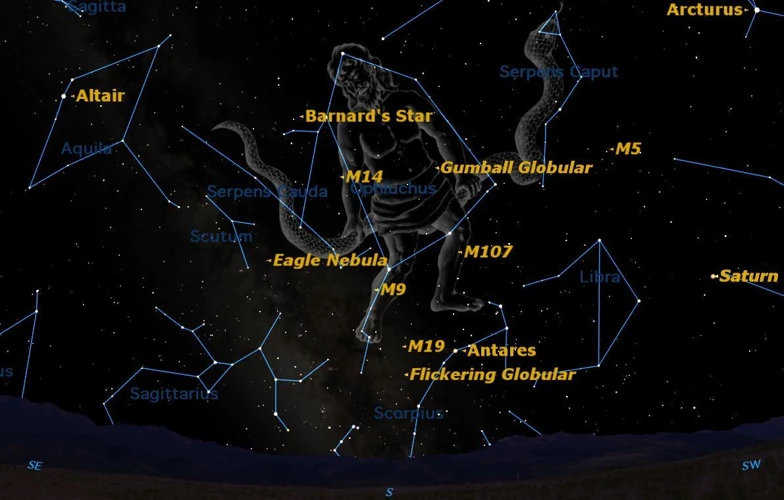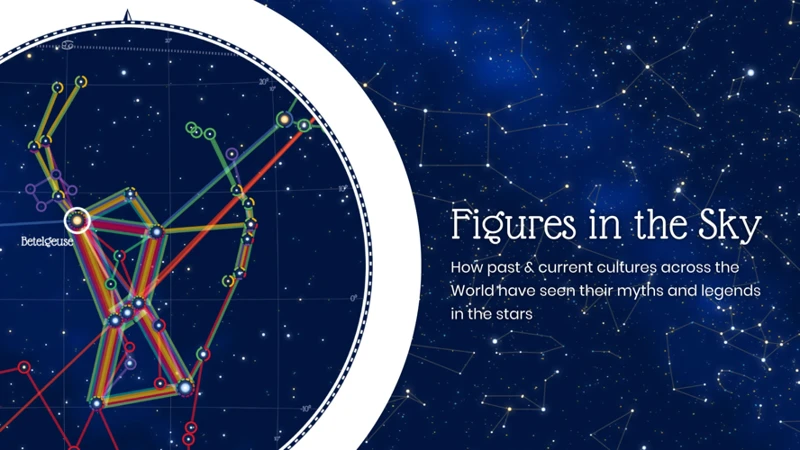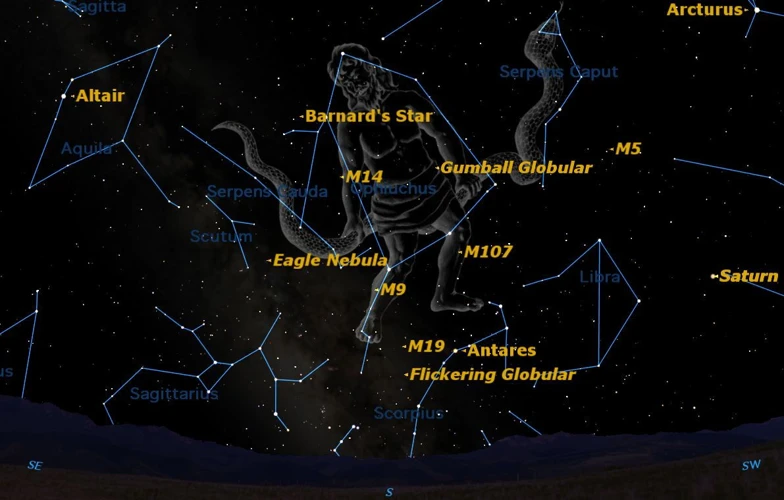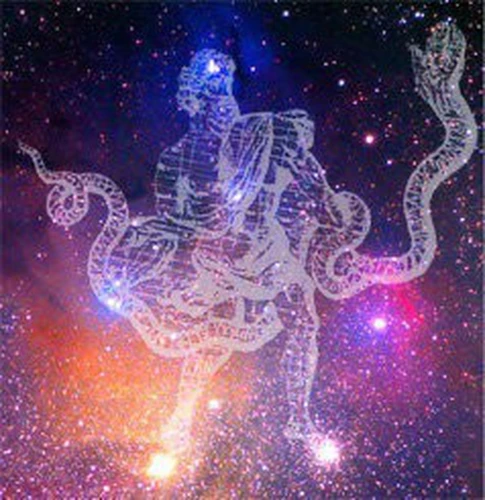The celestial sphere has captivated human imagination since time immemorial. Ancient civilizations looked up at the night sky and saw more than just a random scattering of stars. They identified patterns, gave them names, and wove them into their stories and belief systems. But beyond the realm of mythology, ancient constellations played a crucial role in both navigation and timekeeping. By studying the positions and movements of these celestial formations, early mariners and timekeepers were able to determine their location, navigate treacherous seas, and accurately measure time. In this article, we will delve into the fascinating role of ancient constellations in navigation and timekeeping, exploring their cultural significance, historical methods, and even their enduring impact in modern times. So, let us embark on a celestial journey and uncover the secrets of the ancient skies.
Contents
- Ancient Constellations and Navigation
- Ancient Constellations and Timekeeping
- Constellations: Cultural Significance
- The Modern Relevance
- Conclusion
- Frequently Asked Questions
- References
-
Frequently Asked Questions
- Why were ancient constellations used for navigation?
- How did ancient sailors use constellations to navigate?
- Which constellations were most important for navigation?
- Did different ancient cultures have different constellations for navigation?
- How did ancient civilizations keep track of time using constellations?
- What were ancient timekeeping methods before clocks and watches?
- Did all ancient civilizations use constellations for timekeeping?
- How did ancient civilizations view constellations from a cultural perspective?
- Are ancient constellations still relevant in popular culture today?
- How are ancient constellations used in modern astronomy?
- References
- Read More

Ancient Navigation Techniques
Navigating the vast oceans and uncharted territories was no easy task for ancient seafarers. They were devoid of modern instruments like GPS and compasses, relying instead on their astute observation of the night sky. Ancient constellations played a crucial role in their navigation techniques, acting as celestial reference points. Sailors would study the positions and movements of these constellations at different times of the year, which helped them determine their latitude and approximate direction. One notable constellation used for navigation was the Big Dipper, a prominent part of the Ursa Major constellation. Sailors in the Northern Hemisphere would follow the arc of the Big Dipper’s handle to find Polaris, the North Star, which indicated true north. The Southern Cross constellation served a similar purpose for sailors in the Southern Hemisphere, pointing them towards the South Pole. These ancient mariners developed intricate knowledge of the night sky, allowing them to navigate vast distances with remarkable accuracy, all thanks to the guidance of these celestial formations.
The Importance of Constellations
Constellations played a crucial role in ancient navigation for several reasons. Firstly, they provided a fixed and reliable reference point in an otherwise featureless and ever-changing expanse of the open ocean. By memorizing the positions of the constellations and their relation to the horizon, sailors could accurately determine their course and location. Secondly, constellations helped in identifying specific routes and landmarks. Just as we use landmarks on land to navigate, ancient sailors used constellations as their celestial landmarks, guiding them along established trade routes and known destinations. Finally, constellations provided a sense of comfort and familiarity in the vastness of the night sky, offering mariners a connection to the world they left behind and a source of inspiration and hope during their arduous journeys.
Notable Constellations for Navigation
While numerous constellations played a role in ancient navigation, several stood out for their prominence and usefulness. In addition to the Big Dipper and the Southern Cross, Orion, with its distinctive belt of three stars, was also significant. Ancient sailors used the position of Orion in the sky to determine their approximate latitude. Cassiopeia, a prominent constellation in the Northern Hemisphere, was another important navigational aid, serving as a circumpolar constellation that indicated the direction of north. These constellations, along with many others, formed the celestial maps that guided sailors across vast oceans and enabled the exploration and expansion of ancient civilizations. With their knowledge of the night sky and the aid of these constellations, ancient navigators ventured into the unknown and shaped the course of history.
[Internal Link: Follow the enigmatic story of Prometheus and his connection to ancient constellations for a deeper understanding of their mythical significance.](/exploring-enigmatic-story-prometheus/)
Ancient Navigation Techniques
To navigate their way across the vast seas, ancient sailors relied on a variety of techniques and tools, all aimed at understanding their position and charting their course. One of the fundamental techniques utilized was dead reckoning, which involved estimating a ship’s current position based on previously known positions and the speed and direction of travel. While dead reckoning provided a general idea of location, it was prone to accumulating errors over time. To counter this, ancient navigators incorporated celestial navigation into their repertoire. By observing celestial bodies such as the sun, moon, planets, and, most importantly, the stars, mariners could determine their latitude and approximate direction.
One key navigation technique was celestial altitude measurement. Navigators would measure the angle between the horizon and a celestial body, such as the sun or a known star, using an instrument called an astrolabe or quadrant. The angle provided information about the ship’s latitude since the elevation of celestial bodies above the horizon changes depending on the observer’s position on Earth. By comparing the measured altitude with tables indicating the expected altitude for a given latitude and time, sailors could calculate their approximate position.
Another crucial technique was determining the azimuth, which is the angular distance of an object measured clockwise from true north. By using a mariner’s astrolabe or a cross-staff, navigators could measure the angle between a celestial body, such as the sun or a star, and the horizon. This angle, combined with the known time and the estimated latitude, allowed sailors to establish their east-west position and plot their course.
In addition to these techniques, ancient navigators also relied on celestial navigation aids, such as star charts and ephemerides, which provided detailed information about the positions and movements of celestial bodies throughout the year. These tools enabled sailors to accurately predict the positions of stars and plan their voyages accordingly.
[Internal Link: Learn more about the role of asteroids, comets, and planets in ancient navigation and their influence on celestial navigation techniques.](/role-asteroids-comets-planets/)
The Importance of Constellations
The Importance of Constellations
1. Reliable Navigation: Constellations provided a fixed and reliable reference point for ancient navigators. In the vastness of the ocean, where there were no landmarks, constellations served as dependable guides. Sailors could determine their course and location by memorizing the positions of constellations and their relation to the horizon.
2. Landmark Identification: Similar to how we use landmarks on land, ancient sailors used constellations as celestial landmarks. These patterns in the sky helped them identify specific routes and landmarks along their journey. By aligning their position relative to the constellations, they could stay on established trade routes and reach their intended destinations.
3. Comfort and Familiarity: The night sky could be an intimidating and lonely place for ancient seafarers. However, the constellations provided a sense of comfort and familiarity. They served as a connection to the world they left behind and offered inspiration and hope during their long and arduous journeys.
4. Cultural Significance: Beyond their practical purposes, constellations also held cultural and symbolic significance for ancient civilizations. Different cultures associated various myths, legends, and beliefs with specific constellations. These stories added depth and meaning to the navigational use of constellations, providing a link between the celestial and earthly realms.
Learning about the importance of constellations gives us a glimpse into the ingenuity and resourcefulness of ancient navigators. Their knowledge of the night sky, combined with their reverence for these celestial patterns, enabled incredible feats of exploration and discovery. To explore further, delve into the ancient civilizations’ beliefs about zodiac signs and their celestial connections. [Click here to gain insight into the cultural significance of constellations in ancient times.](/ancient-civilizations-beliefs-zodiac-signs/)
Notable Constellations for Navigation
Ancient sailors relied on specific constellations as their guiding lights, aiding them in their journeys across vast oceans. These notable constellations served as dependable navigational tools due to their distinctiveness and visibility. One such constellation is the Big Dipper, part of the Ursa Major constellation. Sailors in the Northern Hemisphere used this easily recognizable formation to locate Polaris, the North Star. By following the arc of the Big Dipper’s handle, they could find their way to true north, providing them with a constant reference point for navigation. In the Southern Hemisphere, sailors looked to the Southern Cross, a distinctively shaped constellation. Its four bright stars guided them towards the South Pole, allowing for navigation in the southern regions. Another important constellation for navigation was Orion, known for its striking belt of three stars. Ancient mariners used the position of Orion in the night sky to approximate their latitude, aiding them in plotting their course. Cassiopeia, a prominent constellation in the Northern Hemisphere, also played a role in navigation. Its shape, resembling a distinctive “W” or “M,” served as a circumpolar constellation, indicating the direction of north. These and other notable constellations became celestial maps, enabling ancient sailors to navigate treacherous waters and discover new lands. Through their understanding of these celestial guides, mariners embarked on legendary expeditions, shaping the course of history.
Ancient Constellations and Timekeeping

Ancient Timekeeping Methods
Before the invention of modern clocks and watches, ancient civilizations relied on various methods to measure time. One of the earliest timekeeping techniques was based on observing the movements of celestial bodies, including ancient constellations. By monitoring the positions and alignments of stars and constellations, ancient timekeepers could track the passage of time, marking the changing seasons, and determining important dates and events.
Role of Constellations in Timekeeping
Ancient constellations played a crucial role in the timekeeping practices of ancient cultures. For example, the movement of the sun in relation to specific constellations helped determine the solstices and equinoxes, which were significant events marking the changing seasons. The constellation of Taurus, associated with the spring equinox, signaled the renewal and rebirth of nature after the cold winter months. Similarly, the constellation of Leo was linked to the summer solstice, representing the peak of warmth and abundance. By observing these constellations, ancient societies could plan their agricultural activities, religious ceremonies, and other important events according to the rhythms of nature and the passage of time.
Ancient astronomers and timekeepers also used the movement of constellations to create calendars and mark the passage of weeks, months, and years. For instance, the ancient Egyptians devised a calendar based on the rising of the star Sirius, which coincided with the annual flooding of the Nile River. Similarly, the Mayans developed a sophisticated calendar system using the movement of the Pleiades constellation to track celestial events and mark the passing of time.
In addition to the practical uses, ancient constellations also held symbolic significance in timekeeping. They were often associated with mythical stories and gods, representing cosmic cycles and celestial powers. These symbolic meanings further enriched the cultural understanding of time and its connection to the celestial realm.
To summarize, ancient constellations served as celestial markers and guides in the measurement and interpretation of time. Their positions and movements were intricately woven into the timekeeping practices of ancient civilizations, providing a holistic understanding of the passage of time and its intimate connection to the celestial world.
[Internal Link: Explore the beliefs and significance of zodiac signs in ancient civilizations for a deeper understanding of the connection between constellations and cultural perspectives.](/ancient-civilizations-beliefs-zodiac-signs/)
Ancient Timekeeping Methods
Ancient Timekeeping Methods
Before the invention of clocks and watches, ancient civilizations developed various methods to measure time. These methods relied on observations of celestial bodies, including the sun, moon, and stars. Here are a few notable ancient timekeeping techniques:
1. Sundials: Sundials were one of the earliest timekeeping devices. They consisted of a stationary rod or pointer, called a gnomon, that cast a shadow onto a marked dial surface. Ancient Egyptians, Greeks, and Romans used sundials to track the movement of the sun and determine the time of day based on the position of the shadow.
2. Water Clocks: Water clocks, also known as clepsydras, measured time by regulating the flow of water from one vessel to another. The rate at which the water flowed provided an approximate measure of time. Ancient civilizations such as the Egyptians, Babylonians, and Greeks utilized water clocks for various purposes, including marking the hours of the day and night.
3. Astrolabes: Astrolabes were intricate instruments used to determine the positions of celestial bodies and calculate time. They consisted of a rotating dial with various markings and adjustable components. By aligning the astrolabe with specific stars or the sun, people could estimate the time of day or night.
4. Observations of Celestial Events: Ancient cultures observed celestial events, such as the changing phases of the moon and the movement of stars, to track the passage of time. The regular patterns and cycles of these celestial events provided a basic framework for measuring seasons, months, and years.
While these ancient timekeeping methods were not as precise as modern timekeeping devices, they allowed civilizations to track time in a way that was essential for agriculture, trade, and societal activities. The observation of ancient constellations played a significant role in calculating time and creating calendars based on the positions and movements of these celestial formations.
[Internal Link: Learn more about the fascinating role of asteroids, comets, and planets in ancient civilizations’ beliefs and their connection to the study of ancient constellations.](/role-asteroids-comets-planets/)
Role of Constellations in Timekeeping
Ancient Timekeeping Methods
Timekeeping has always been a fundamental human need, and ancient civilizations developed various methods to measure the passage of time. One of the most significant contributions of ancient constellations was their role in timekeeping. Before the invention of mechanical clocks, people relied on the celestial movements to determine the time of day and track the progression of seasons. Ancient timekeeping methods were primarily based on the apparent motion of the Sun, Moon, and stars across the sky. By observing the position of constellations relative to the horizon, ancient astronomers and timekeepers could approximate the time of day or night.
Role of Constellations in Timekeeping
Constellations played a crucial role in timekeeping by serving as markers of the changing seasons. As they slowly moved across the sky throughout the year, different constellations would become visible at different times. By noting the position of specific constellations throughout the night, ancient timekeepers could estimate the hour and keep track of the seasons. For example, the appearance of certain constellations, such as the Pleiades in the pre-dawn sky, signaled the arrival of spring, facilitating agricultural activities and guiding the planting of crops. Similarly, the rising and setting of constellations like Orion or Scorpius indicated the changing of seasons, helping ancient civilizations anticipate weather patterns and organize their activities accordingly.
The ancient Egyptians were particularly skilled in utilizing constellations for timekeeping. They followed the annual rising of the star Sirius, also known as the Dog Star, which coincided with the flooding of the Nile River. The timing of this event was crucial for their agricultural calendar, as it marked the beginning of a new planting season. By observing the position of Sirius and its correlation with other constellations, the Egyptians were able to develop a sophisticated calendar system that aligned with the natural rhythms of the celestial bodies.
The ancient Greeks also employed constellations for timekeeping. The position of the constellation Perseus, for example, served as their reference point for determining the time of sunset. As Perseus was visible in the evening sky during certain months, its position allowed them to estimate the beginning of twilight and the transition from day to night.
Through their diligent observation and interpretation of constellations, ancient cultures were able to create rudimentary timekeeping systems that guided their daily lives and societal activities. The connection between constellations and time persisted throughout history, forming the foundation for future advancements in the field of time measurement and leading to the development of more accurate timekeeping methods.
[Internal Link: Explore more about the role of asteroids, comets, and planets in ancient civilizations and their impact on celestial observations.](/role-asteroids-comets-planets/)
Constellations: Cultural Significance

Ancient Civilization Perspectives
The cultural significance of constellations extends beyond navigation and timekeeping. Different ancient civilizations had their own unique perspectives and interpretations of these celestial formations. For example, in ancient Egypt, the constellation of Orion was associated with the god Osiris and was believed to be a representation of the pharaoh’s journey to the afterlife. In Greek mythology, the constellation of Ursa Major, also known as the Great Bear, was connected to the story of Callisto, turned into a bear by the jealous goddess Hera. These stories and associations with constellations were woven into the fabric of society, influencing everything from religious rituals to artistic representations.
Mythological Interpretations
The mythological interpretations of constellations played a significant role in ancient cultures. They served as celestial narratives, telling stories of gods, heroes, and mythical creatures. These stories not only entertained but also served as moral lessons and explanations for natural phenomena. The constellation of Scorpius, for example, was associated with the Greek myth of Orion and the scorpion that stung him to death. This myth provided an explanation for the changing position of Orion in the sky throughout the year. Similarly, the constellation of Taurus was linked to the myth of Zeus transforming into a bull to carry away the princess Europa. These mythological interpretations added a layer of richness and depth to the constellations, making them a vital part of cultural and artistic expressions in ancient civilizations.
The cultural significance of constellations extended beyond their mythological interpretations as well. They were often used to mark significant celestial events, such as solstices, equinoxes, and the movement of celestial bodies like comets and planets. These events held great importance in the religious and agricultural calendars of ancient civilizations. By observing the positions and alignments of constellations during these events, ancient cultures could predict the changing seasons, plan agricultural activities, and perform religious rituals accordingly.
Ancient civilizations also used constellations as a means of storytelling and passing down oral traditions. They connected the dots in the sky to create their own narratives and folklore. These stories were memorized and shared through generations, preserving cultural heritage and identity. In this way, constellations became an integral part of the collective memory and cultural fabric of ancient civilizations.
The cultural significance of constellations was vast and multifaceted. They were a source of inspiration, guiding principles, and a connection to the divine and the natural world. The interpretations and associations varied from culture to culture, but the underlying belief in the power and significance of these celestial formations was universal. Today, we continue to explore and appreciate the cultural heritage embedded within constellations, paying homage to the ancient civilizations that relied on these celestial wonders for their cosmic narratives.
[Internal Link: Learn more about the beliefs and interpretations of zodiac signs in ancient civilizations for a deeper understanding of their cultural significance.](/ancient-civilizations-beliefs-zodiac-signs/)
Ancient Civilization Perspectives
Ancient Civilization Perspectives
Ancient civilizations across the globe held a deep reverence for the night sky and the constellations that adorned it. These celestial formations were not only seen as navigational tools but also held cultural and spiritual significance. Different civilizations had their own unique perspectives on the constellations, weaving them into their belief systems and mythologies.
1. Ancient Egypt:
In ancient Egypt, the Nile River played a vital role in their civilization, and the annual flooding of the river was essential for their agricultural practices. The rising of the star Sirius, known as the “Dog Star,” coincided with the Nile floods. This celestial event was a significant marker for the Egyptians, symbolizing the rebirth and fertility brought by the annual inundation.
2. Ancient Greece:
The Greeks, known for their contributions to astronomy, had their own interpretations of constellations. One of the most famous Greek constellations is Orion, the mighty hunter. According to Greek mythology, Orion was a great hunter who was eventually placed in the stars by the gods. The constellation Hercules was also revered by the Greeks as a symbol of strength and heroism.
3. Ancient China:
In ancient China, the constellations were closely tied to the Chinese Zodiac, a system of astrological signs based on the lunar calendar. The Chinese Zodiac consists of twelve animal symbols, with each year associated with a specific animal. The movements of the constellations helped the ancient Chinese track time, predict the seasons, and make important agricultural decisions.
4. Ancient Maya:
The ancient Maya civilization, renowned for their advanced understanding of astronomy, had a rich celestial mythology. They believed that the gods resided in the stars, and the movements of the constellations were seen as divine messages. They carefully observed celestial events such as eclipses and used them to create calendars for their agricultural and religious activities.
5. Ancient India:
In ancient India, the constellations held great astrological significance. The Nakshatra system, consisting of 27 lunar mansions or asterisms, played a crucial role in Indian astrology. Each Nakshatra had its own symbolism and attributes, guiding various aspects of life, such as personality traits, behavior, and compatibility.
These are just a few examples of how ancient civilizations perceived and integrated constellations into their cultures and belief systems. The night sky served as a canvas for their mythologies, guiding their daily lives, spiritual practices, and understanding of the world. Today, we can explore these ancient perspectives and gain a deeper appreciation for the cultural significance of constellations.
[Internal Link: Discover more about the beliefs and interpretations of ancient civilizations regarding zodiac signs and their connection to constellations.](/ancient-civilizations-beliefs-zodiac-signs/)
Mythological Interpretations
Mythological Interpretations
In addition to their practical significance in navigation and timekeeping, ancient constellations held profound mythological interpretations across cultures. These celestial formations were often associated with captivating stories, gods, and heroes, adding an enchanting layer to their cultural significance.
Greek Mythology
Greek mythology, for instance, abounds with tales about the origin of constellations. Orion, the great hunter, was said to have been placed among the stars after his death, his mighty figure immortalized forever. The Pleiades, a cluster of stars in the Taurus constellation, were believed to be seven sisters transformed into stars by Zeus to protect them from the relentless pursuit of Orion. The constellation Cassiopeia, known for its distinctive ‘W’ shape, was said to represent a vain queen who boasted about her beauty, resulting in her punishment of being tied to a celestial throne forever.
Egyptian Mythology
In Egyptian mythology, the constellation Orion represented Osiris, the god of the afterlife, rebirth, and regeneration. Osiris was believed to embody the cycle of life, death, and resurrection, and his presence in the night sky symbolized the promise of eternal life.
Chinese Mythology
Chinese mythology also assigned great significance to the constellations. The constellation of the Big Dipper, known as the “Northern Dipper” in Chinese culture, was considered to be a heavenly palace where the gods resided. The seven stars of the Big Dipper were seen as powerful deities, and their positions in the sky were believed to have a direct influence on life events and fortune.
These mythological interpretations of constellations added depth and meaning to ancient cultures, influencing their religious practices, storytelling traditions, and even their understanding of the world. The night sky served as a canvas for these captivating tales, connecting the celestial realm with earthly experiences.
[Internal Link: Explore the beliefs and significance of zodiac signs in ancient civilizations to gain a deeper understanding of how constellations influenced their cultural identities.](/ancient-civilizations-beliefs-zodiac-signs/)
The Modern Relevance

Ancient Constellations in Popular Culture
In modern times, ancient constellations continue to capture our imagination and play a significant role in popular culture. Books, movies, and television shows frequently draw inspiration from these celestial formations to create captivating stories. From the famous constellation of Orion that inspired characters like Luke Skywalker in Star Wars, wielding a lightsaber reminiscent of Orion’s belt, to the zodiac signs based on ancient constellations that people use to determine their horoscopes and personality traits, these ancient celestial patterns have become deeply ingrained in our cultural consciousness.
The Use of Ancient Constellations Today
While modern navigational techniques rely on advanced technology, ancient constellations still hold practical value in some contexts. Amateur astronomers and stargazers often use constellations as guideposts to locate and identify celestial objects. Identifying constellations and their patterns can be a fun and educational activity, connecting us to the ancient past and expanding our knowledge of the universe. Additionally, a deeper understanding of ancient constellations can enhance our appreciation of historical artifacts and artwork, as many ancient civilizations depicted these celestial patterns in their architecture, pottery, and paintings.
There is ongoing scientific research focused on ancient navigation techniques and the role of constellations. By studying the ancient methods and applying them to modern challenges, researchers seek to find alternative and sustainable navigation solutions. This interdisciplinary approach combines historical knowledge with technological advancements, demonstrating the lasting impact and relevance of ancient constellations in the contemporary world.
Ancient constellations continue to captivate and inspire us in the modern era. From their presence in popular culture to their practical value in astronomy and navigation, these celestial formations remain culturally significant and scientifically intriguing. Exploring ancient constellations allows us to connect with our past, appreciate the artistry of ancient civilizations, and gain a deeper understanding of the vastness and wonders of the universe.
Ancient Constellations in Popular Culture
Ancient Constellations in Popular Culture
The influence of ancient constellations extends far beyond their historical significance. These celestial formations have become deeply ingrained in popular culture, inspiring art, literature, and even modern technology. One prominent example of ancient constellations in popular culture is their representation in astrology and horoscopes. The zodiac signs, deriving from ancient Babylonian and Greek interpretations of constellations along the ecliptic, continue to be used today to interpret personality traits and predict future events. Each zodiac sign is associated with a specific constellation, such as Aries with the ram or Leo with the lion, creating a connection between individuals and the ancient astronomical patterns.
Ancient constellations have also found their way into various forms of artwork. Paintings, sculptures, and even tattoos often feature depictions of these celestial patterns, capturing the mystique and beauty associated with the night sky. Artists draw inspiration from the stories and mythologies associated with these constellations, creating captivating and thought-provoking pieces that resonate with audiences. Ancient constellations also play key roles in literature, serving as symbols and metaphors to convey deeper meanings. Authors and poets use constellations to explore themes of navigation, destiny, and human connection, linking their characters’ journeys with the timeless significance of the stars.
In modern technology, ancient constellations find their place in various applications. One intriguing use is in satellite-based navigation systems, like GPS (Global Positioning System). GPS utilizes a network of satellites that orbit Earth, accurately determining location by triangulating signals from these satellites. Each satellite is named after a constellation, such as Navstar, which stands for Navigation Satellite Timing and Ranging. This integration of ancient constellations into modern technology demonstrates their enduring relevance and the ongoing fascination with these celestial formations.
Whether as a source of inspiration for artists, a tool for navigational systems, or a basis for astrological beliefs, ancient constellations continue to captivate and impact popular culture. Their enduring presence reminds us of humanity’s connection with the stars and the wonder and awe they have instilled in us for thousands of years.
[Internal Link: Explore more about the ancient civilizations’ beliefs in zodiac signs and the significance of constellations in their cultures.](/ancient-civilizations-beliefs-zodiac-signs/)
The Use of Ancient Constellations Today
The Use of Ancient Constellations Today
While modern navigation technology has made ancient methods obsolete in most practical applications, the use of ancient constellations still holds cultural and symbolic significance in the modern world. One of the most prominent ways ancient constellations are used today is in astronomy and stargazing. Amateur astronomers and enthusiasts continue to study and identify these ancient formations, marveling at their beauty and connecting with the night sky. Additionally, ancient constellations still serve as a source of inspiration in various forms of art and literature, with their mythical stories and symbolic meanings woven into contemporary works. Ancient constellations play a role in astrology, where the zodiac signs are based on specific constellations. Many people still consult horoscopes and find personal meaning and guidance in the alignment of the stars. The constellations from ancient civilizations continue to captivate our imagination and remind us of the rich history and profound connection between humanity and the cosmos.
| Modern Uses of Ancient Constellations |
| 1. Astronomy and Stargazing |
| 2. Art and Literature |
| 3. Astrology and Zodiac Signs |
Conclusion

In conclusion, ancient constellations played a vital role in both navigation and timekeeping for ancient civilizations. They provided mariners with a reliable method of determining their location and direction on vast oceanic voyages. By studying the positions and movements of constellations such as the Big Dipper, Orion, and Cassiopeia, sailors could navigate with remarkable accuracy, ensuring safe passage to their destinations. Furthermore, constellations served as celestial landmarks, guiding sailors along established trade routes and offering a sense of familiarity in the night sky.
Constellations also played a significant role in ancient timekeeping. Early timekeepers used the movement of constellations to mark the passage of time, allowing them to divide the year into seasons and track celestial events such as solstices and equinoxes. This knowledge of timekeeping provided a foundation for the development of calendars and the organization of agricultural activities.
Beyond their practical applications, constellations held cultural and mythological significance. They were woven into the fabric of ancient civilization perspectives, reflecting their beliefs, values, and stories. The mythological interpretations of constellations added depth and meaning to their existence, connecting the celestial world with the human experience.
While modern technology has provided us with advanced navigation and timekeeping tools, the legacy of ancient constellations lives on. They continue to inspire and captivate us, serving as symbols of our human connection to the cosmos. In popular culture, ancient constellations are referenced in literature, artwork, and even naming celestial bodies. Additionally, amateur astronomers and stargazers still find joy in identifying and observing these ancient formations in the night sky.
In conclusion, ancient constellations not only guided ancient mariners and timekeepers but also provided a rich tapestry of cultural significance and continue to spark wonder and fascination in our modern world. The study and appreciation of ancient constellations allow us to be in awe of the vastness and beauty of the universe and our place within it.
Frequently Asked Questions

1. How did ancient civilizations navigate without modern instruments?
Ancient civilizations relied on astute observation of the night sky, using constellations as celestial reference points to determine their location and direction.
2. Which constellations were used for navigation?
The Big Dipper, Southern Cross, Orion, and Cassiopeia were notable constellations used by ancient sailors for navigation purposes.
3. How did sailors use the Big Dipper for navigation?
In the Northern Hemisphere, sailors would follow the arc of the Big Dipper’s handle to find Polaris, the North Star, which indicated true north.
4. What was the significance of the Southern Cross?
The Southern Cross constellation served as a navigational aid for sailors in the Southern Hemisphere, pointing them towards the South Pole.
5. Why were constellations important for ancient navigation?
Constellations provided fixed reference points and helped sailors determine their course, location, and identify specific routes and landmarks.
6. How did constellations provide comfort to sailors?
Constellations offered a sense of familiarity and connection in the vastness of the night sky, providing inspiration and hope during long journeys.
7. How did sailors use Orion for navigation?
Ancient sailors used the position of Orion in the sky to determine their approximate latitude.
8. What role did Cassiopeia play in navigation?
Cassiopeia, a prominent circumpolar constellation in the Northern Hemisphere, indicated the direction of north, aiding sailors in navigation.
9. Were there other constellations used for navigation?
Ancient civilizations used a variety of constellations besides the notable ones mentioned, incorporating their unique star patterns into their navigation techniques.
10. How accurate were ancient sailors in using constellations for navigation?
Ancient sailors developed intricate knowledge of the night sky, allowing them to navigate vast distances with remarkable accuracy using constellations as their celestial guides.
References
- Humans have long used the stars for navigation
- The use of Constellations in Navigation and Orientation
Frequently Asked Questions

Ancient civilizations used constellations for navigation because they provided a fixed reference point in the night sky, allowing sailors and explorers to determine their position and navigate accurately.
Ancient sailors used constellations as landmarks to navigate the seas. By observing the positions of specific constellations at different times of the year, they could determine their latitude and direction.
The most important constellations for navigation varied depending on the region and time period. However, some notable constellations used for navigation include the Big Dipper, North Star (Polaris), Southern Cross, and Orion.
Yes, different ancient cultures had their own set of constellations for navigation. For example, Polynesians used constellations like the Pleiades and Orion’s Belt, while the Egyptians relied on constellations like Sirius and Orion.
How did ancient civilizations keep track of time using constellations?
Ancient civilizations used constellations as a celestial clock. By observing the position of specific constellations in the sky, they could determine the time of year, track the changing of seasons, and even mark important celestial events like solstices and equinoxes.
What were ancient timekeeping methods before clocks and watches?
Before clocks and watches, ancient civilizations relied on various timekeeping methods. Some examples include sundials, water clocks, and observing the movement of celestial bodies like the sun, moon, and stars.
Did all ancient civilizations use constellations for timekeeping?
Not all ancient civilizations used constellations for timekeeping, but many did. Cultures like the Egyptians, Greeks, Mayans, and Chinese all had intricate systems of celestial timekeeping that incorporated constellations.
How did ancient civilizations view constellations from a cultural perspective?
Ancient civilizations often assigned mythical or religious significance to constellations. They were seen as celestial characters in stories and legends that represented gods, heroes, and important aspects of their culture’s beliefs and values.
Are ancient constellations still relevant in popular culture today?
Ancient constellations continue to be relevant in popular culture today. They are often featured in literature, art, movies, and even modern astrology. Many people still find fascination in connecting with the ancient wisdom and stories associated with these constellations.
How are ancient constellations used in modern astronomy?
Ancient constellations are still used in modern astronomy as a reference system for naming and locating celestial objects. Astronomers use these traditional constellations as a way to communicate and identify specific areas of the night sky.







